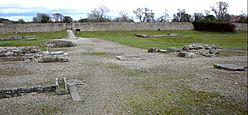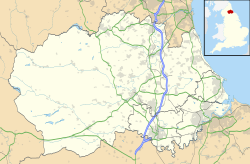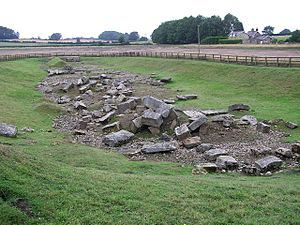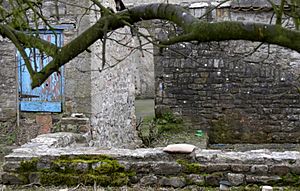Piercebridge Roman Fort facts for kids
Quick facts for kids Piercebridge Roman Fort |
|
|---|---|

Piercebridge Roman Fort
|
|
| Alternative name(s) | Morbium, Vinovium |
| Founded | c. 2nd century AD |
| Abandoned | 5th or 6th century AD |
| Place in the Roman world | |
| Province | Britannia |
| Stationed military units | |
| — Legions — | |
|
|
| Location | |
| Coordinates | 54°32′06″N 1°40′41″W / 54.535°N 1.678°W |
| Place name | Piercebridge |
| County | County Durham |
| Country | England |
| Reference | |
| UK-OSNG reference | NZ209156 |
| Site notes | |
| Excavation dates |
|
| Archaeologists |
|
| Exhibitions | |
The Piercebridge Roman Fort (which might have been called Morbium or Vinovium) is an important ancient site. It is located in the village of Piercebridge in County Durham, England. This fort sits right by the River Tees. Roman soldiers lived here from about 70 AD until at least the early 5th century.
Near the fort, there was a civilian settlement called a vicus and a bath house. Another vicus and a villa were found south of the river at Cliffe, Richmondshire. People in the Victorian times even used carved stones from this fort to build St Mary's church in Gainford, County Durham. Today, part of the fort is hidden under the Piercebridge village green.
The fort was built on Dere Street, a major Roman road connecting York to the north. Its location was perfect for controlling where the road crossed the River Tees. There was also a large Roman bridge here.
Contents
History of the Fort
Signs in the village green at Piercebridge show that a Roman fort lies underneath. This fort was likely named Magis or Morbium. It was very important for guarding Dere Street, the main Roman road.
Piercebridge was the most southern of four Roman forts along Dere Street in County Durham. The other forts were at Binchester, Lanchester, and Ebchester. Things found at Piercebridge suggest Romans were in the area around 70 AD. They probably defended a ford or ferry crossing from the local Brigantes tribe.
A civilian settlement grew in the Toft field by 125 AD. A military camp appeared south of the Tees in the late 2nd century. However, the main fort you can see today was built later, around 260 to 270 AD. At this time, other Roman settlements nearby started to shrink. The fort was kept up from about 290 to 350 AD. By then, most people lived inside the fort walls. It was used until the 6th century, though some think it was left empty in the early 5th century. It is now a protected historical site. Another Roman fort was also near a bridge in this area, at Greta Bridge.
Fort Design and Bridge
The Piercebridge fort followed a typical Roman design. It was rectangular with towers at each corner. It also had two large gates for Dere Street.
Inside the fort, there were barracks for soldiers. There were also workshops, granaries for storing food, and the main army headquarters. The commander of the fort had his own separate house.
The bridge that crossed the river had a south end and four supports. However, some archaeologists think the remains are not a bridge at all. They suggest it might be a dam and a spillway. If it is a Roman bridge, it would be one of only two left in England. The other one is Chesters Bridge.
The Civilian Town (Vicus)
East of the fort, in Tofts Field, was a vicus. This was a civilian town that started in the 1st century AD. It lasted until the early 5th century. People in the vicus provided goods and services to the soldiers in the fort.
Marks seen from above (called cropmarks) show it had about thirty buildings. Its residents likely traded using the river from the late 1st century. Fewer people lived there once the fort's strong walls were built. This vicus probably grew after a Roman villa was built south of the river at Holme House. That villa started as a native roundhouse. There was also another vicus on the other side of the river crossing, at Cliffe, Richmondshire.
The Bath House
A Roman bath house was still standing in the 13th century. St Mary's chapel was built to include part of it. You can still see a wall with a rounded archway from a distance. This bath house was for the soldiers to wash and relax. It was built outside the fort, which was common for Roman bath houses. It is now a very important historical building and a protected ancient site.
Archaeological Discoveries
Around 1910, Edmund Wooler found a large, carved Roman stone. He believed it was part of the original Roman bridge.
Because modern Piercebridge did not grow beyond the original Roman fort area, the old earthworks (mounds and ditches) on the north and west sides are still there. Parts of these have been dug up by archaeologists. An excavation in 1938 found a guard room on each side of the western gate. They also uncovered part of the outer wall near the north-west corner. In 1939, they found part of the south outer wall.
Another dig was done by Dennis Harding and Peter Scott between 1969 and 1981. A dig in 1973 found a rectangular building from the 3rd century. It had a hypocaust, which was an ancient Roman heating system.
The TV show Time Team explored Piercebridge Roman Fort in 2009. They found early bridge timbers in the riverbed that were Roman. Among their discoveries were a small lead goat and a hairpin. They also found one path of Dere Street leading to a bridge, dating back to the time of Emperor Domitian.
Archaeologist Dr David Mason looked at the site again in 2006. All the records and finds from the excavations are kept at the Bowes Museum.
Inscriptions found here show that soldiers from three different Roman legions were present: the Legio II Augusta, the Legio VI Victrix, and the Legio XXII Primigenia. People also worshipped Roman gods like Jupiter and Mars here.
Other finds include a bronze statue of a ploughman with oxen, which is now in the British Museum. Roman coins from the early 4th century have also been found. St Mary's church in Gainford, built in 1855, contains Roman carved stones from this site. Archaeologists have also found kilns and Roman pottery, a metalworking area, a carved stone altar, and burials. These burials included gravestones and a lead coffin.
Visiting the Site
You can see Roman remains at the eastern part of the site. These include parts of the east gate and the fort walls. There is also a courtyard building and an old Roman road inside. A section of the eastern wall is now protected and open for visitors. The original rectangular defence pits are now covered with grass. These were obstacle pits, like hidden holes with sharp wooden stakes. They were designed to trap attackers.
Beyond the fort wall, there was a road with a drain or culvert, which you can still see.
The commander's large house is past this road. It was built on river-pebbles. He had his own bath house, which is at the north of the site on private land. You can see it over a fence. Admission to the public display area is free, and it is open all year. A large part of the 11-acre fort is now under later buildings.
Some of the items found at the site are on display at the Bowes Museum in Barnard Castle.
You can also see remains of the bridge that carried Dere Street over the River Tees. These are on the south side of the river at Cliffe, Richmondshire.






